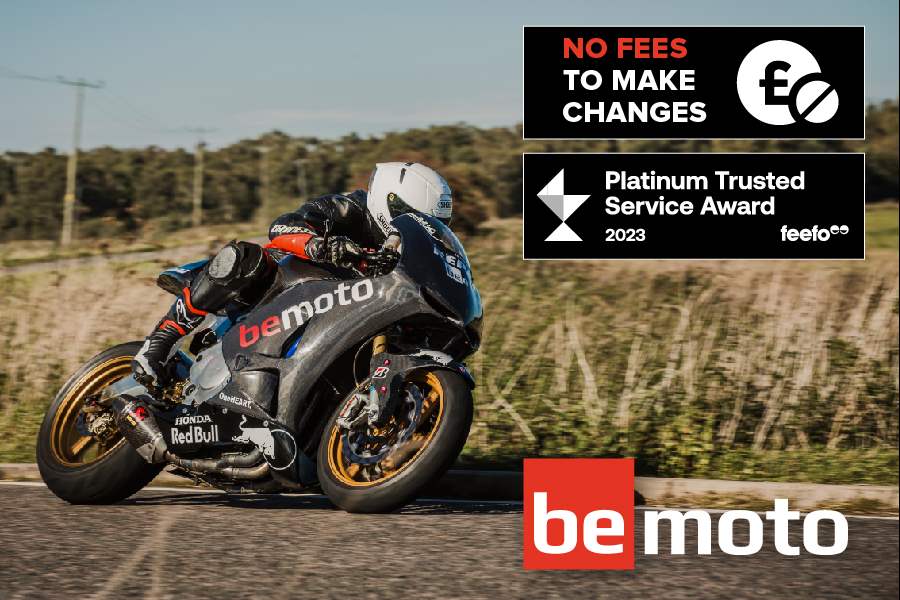How to Secure the Best Motorbike Insurance Premiums
Unleash the power of savings: here’s how to make sure you get the best insurance premium for your motorcycle insurance policy.

Riding a motorbike offers a thrilling experience on the open road and sometimes the track, but it's vital that riders protect their pride and joy with the right insurance cover. While some factors that affect your premium are beyond your control, there are several savvy strategies you can employ to trim down the cost of your bike insurance and, in some cases, significantly increase your protection.
With the help of the motorcycle insurance experts at BeMoto, we're going to explore some practical tips and insightful advice to help you secure the best motorbike insurance premiums for you, your bike and the way that you ride.

1. Choose a broker that cares
When selecting an insurance broker, opt for one that understands your needs and offers customer-centric services. If you can, it’s also important to choose an insurer that specialises in motorcycles and isn’t a multi-product brand that can cover your house, car, bike, and pet under one roof. The price may look enticing at first, but should you need to use the cover you might miss that special insight you’ll only get from an expert.
For instance, a company like BeMoto was created by bikers, for bikers. And, while BeMoto can cover some of the other things that a biker will need (cover for race vans for trackday riders, kit and clothing cover, GAP insurance, and travel insurance, for example), its core business is still and always will be bikes and the people that ride them. They also don't charge amendment fees for policy changes. Remember, it's not just about the upfront cost of a policy but also the flexibility and convenience of adapting your policy as circumstances change.
.JPG?width=1600)
2. Prioritise bike security
While enhancing your bike's security won't necessarily reduce your premium directly, it plays a vital role in safeguarding your prized possession. Invest in rated security devices like alarms and trackers, and ensure your bike is stored in a locked building, even if it's a modest shed or conservatory. By making theft more challenging, you'll not only protect your bike but also demonstrate your commitment to security.
Insurers do view physical security devices favourably and in some cases insist on having them. For more expensive bikes even a tracker may be required to get insurance. While we’re on that topic, Trackers can save you some money thanks to the high success rate of getting your bike back, but they will seldom pay for themselves in premium reduction. But that vastly improved chance of recovery is key, and protects you from all the expenses associated with a loss claim where the bike is not recovered.

3. Tailor your mileage
Consider the actual mileage you require for your bike. If you predominantly use it for occasional sunny Sunday rides, paying for 10,000 miles of coverage might be unnecessary.
Opt for a policy from a company that provides flexible mileage options, such as BeMoto, which allows you to adjust your mileage without amendment fees. This way, you can increase your mileage if needed with minimal hassle and expense.
Also, don’t stick to round numbers. Insurers use tiered mileage systems to calculate premiums. If you have a bike specialist broker like BeMoto, its team will know where the wiggle room is, but if you use another broker consider 2,999 miles as opposed to 3,000 where the rate may begin to increase.

4. Realistic bike value
Karl at BeMoto explains, “A lot of people will get a renewal quote through and then go on to get comparable quotes, but they will estimate a lower value than they gave their existing insurer 12-months previously. This gives the misconception that their existing insurer hasn’t given them a good quote, when in fact it might just be that the value on the renewal quote needs some adjustment. This is particularly true with new bikes after their first year of cover when the most depreciation in value occurs”.
The value of your bike should be a yearly consideration and adjusted to suit. Conversely, if your bike is an appreciating classic or modern classic machine, keep an eye on what similar bikes are selling for, and be sure to adjust accordingly.

5. Annual payments vs. instalments
Opting to pay for your insurance coverage annually instead of through monthly instalments can result in savings. BeMoto offers competitive interest rates if you need to pay monthly, but keep in mind that paying upfront annually can help you avoid additional charges and save money in the long run.
6. Consolidate your coverage
If you own multiple bikes, consider consolidating them under a multi-bike policy. This approach allows you to combine your bike collection while benefiting from a single no-claims bonus. Since you can only ride one bike at a time, this can lead to potential savings and streamlining of your insurance coverage. Everyone has unique tastes and different collections of bikes, but not all insurers will cover all bikes, so choose a bike specialist provider that could mix a collection of road, track and dirt bikes for instance, and still offer you savings and the convenience of having one policy and one policy renewal date.

7. Enhance your riding skills
Investing in advanced riding qualifications, such as those offered by the Institute of Advanced Motorists (IAM), Enhanced Rider Scheme (ERS), or RoSPA Advanced Motorcycle Training, can demonstrate your commitment to safe riding practices. Many insurers recognise these qualifications and may offer premium discounts as a result.

8. Choose the right bike, right from the start
When selecting a bike, consider your riding experience, and intended use. If you're a novice rider, opting for what you might consider a ‘starter bike’ like a 600cc naked/commuter is a wise choice compared to a high-performance sports bike or hyper-naked. Additionally, keep in mind that high-value bikes will most likely need to be stored in a locked building, and in cases (and parts of the country) may require extra security to be utilised. Karl from BeMoto told us “We see a lot of ambition outweighing wallet size sadly; the majority of challenges we have in insuring a bike come from similar scenarios: inexperienced riders wanting a bike that has “R” emblazoned on its fairing; riders with some experience making a leap in horsepower; experienced riders wanting to use a superbike for commuting/personal business use, and yes, we even get people wanting to park their shiny new £30k bike on a main road over night. None of these situations make a policy either easy to find or cost-effective.”
_3.jpg?width=1600)
9. Adjust your voluntary excess
Increasing your voluntary excess can often lead to better premium discounts. However, it's crucial to assess your financial situation and determine whether you can afford to cover the increased excess amount in the event of a claim. Find a balance that provides savings without compromising your ability to handle unexpected expenses.
BeMoto has a great solution in this scenario – Excess Contribution Insurance for up to £500. By adding such a product and upping the excess, you could save and have the Excess Contribution Policy pay for itself, and only pay a nominal extra amount on top of your annual premium.
When it comes to securing the best motorbike insurance premiums, a combination of savvy choices, proactive measures, and responsible decision-making can make all the difference. Now we know that doesn’t sound very exciting, but picture this… More money in your pocket to spend on your bikes, bike gear, or trips out!
While some factors may be beyond your control, leveraging the tips discussed in this article can help you reduce costs, it's not just about saving on premiums – it's about protecting your beloved bike and enjoying worry-free rides for years to come.
When the time is right, give the guys at BeMoto a shout on 01733 907 000 and see what they can do for you with your motorcycle insurance review!



